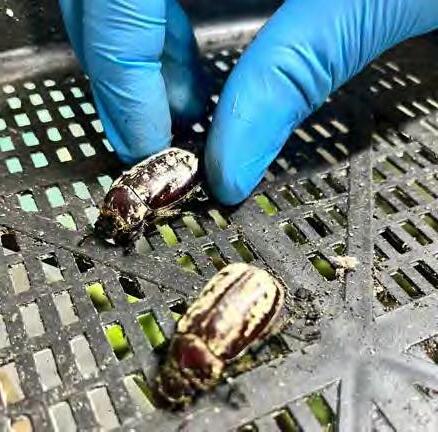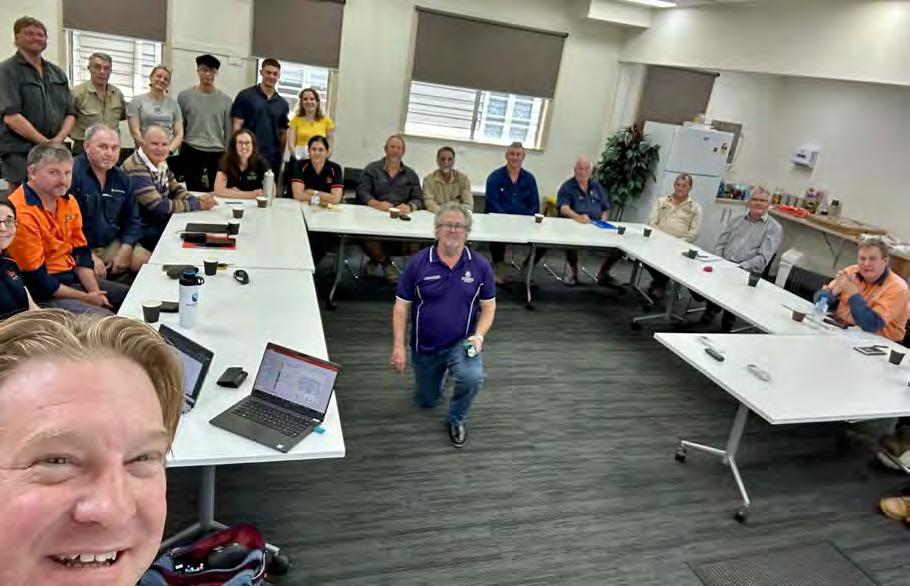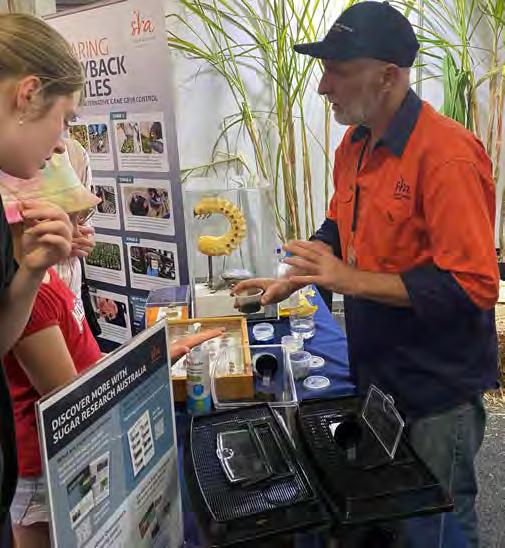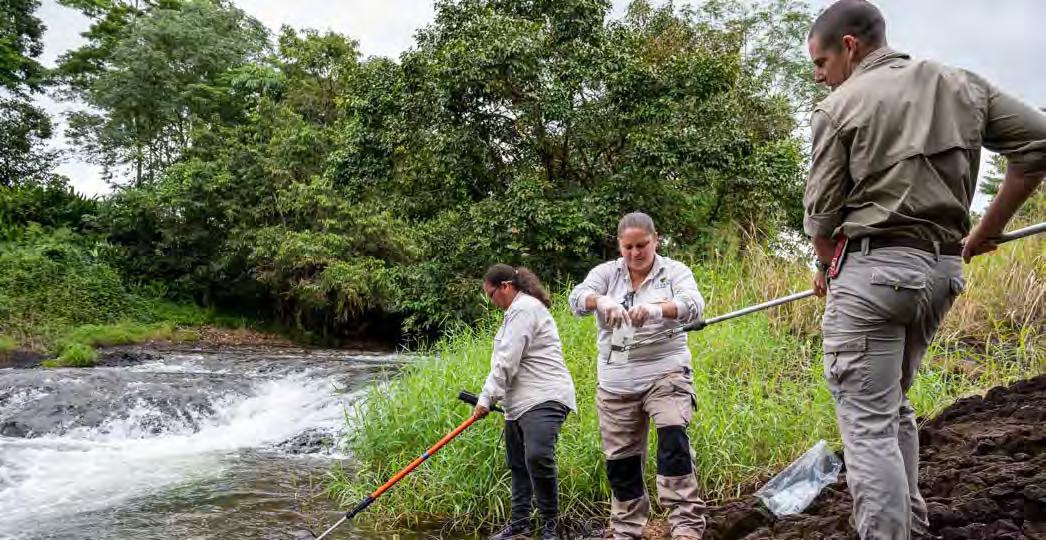
9 minute read
GRUB CONTROL OPTIONS NEED WISE USE OF CHEMICALS
As the Australian government considers new regulations for the only current chemical control for canegrubs, progress is being made in finding an alternative. At the same time, growers have managed to significantly reduce runoff of the insecticide into coastal waterways.
Imidacloprid is used by many agricultural industries across Australia to control pest insects and in the sugarcane sector, it’s the only current option for dealing with destructive canegrubs. It’s been banned or restricted in many parts of the world, mainly because of its effect on bee populations, and the Australian Government has been assessing whether to follow suit However, sugarcane growers are now among those leading the way in successfully reducing the environmental impact of the insecticide, specifically its effects on aquatic life.
Since 2018, there’s been a distinct downward trend in detections of imidacloprid in the Tully, Johnstone, Mulgrave and Murray catchments of the Wet Tropics, while promising results are also coming out of the Herbert and Burdekin districts.
Terrain Natural Resource Management’s Water Quality Monitoring Leader Alicia Buckle has been running a number of projects, including local scale water quality monitoring across the Tully, Johnstone and Murray basins, and said detections of imidacloprid have consistently reduced in creeks and rivers at the sub-catchment scale.
“At some sites we’ve seen a 10-fold decrease in imidacloprid concentrations and far fewer exceedances of guideline values in 2023 compared to what we saw at the same sites in 2018,” she said. “If it’s below the guideline, it’s considered of low risk to the aquatic environment.”
The catchments take in both sugarcane and banana growing areas and Alicia said there has been a collaborative, multi-organisational effort to achieve these results.
From what we can see so far, farmers are doing a pretty good job of managing it
“There’s still some work to be done but I think what we’re seeing is evidence that, when used appropriately, we can greatly reduce the risk to aquatic life.
“It’s a very similar story across both industries in that growers are increasingly being more observant and only using it when and where they need to use it.”
Dr Ryan Turner, Science Leader of the Reef Catchments Science Partnership at the University of Queensland, has been studying imidacloprid detections at end of catchment since 2009.
He says the question of why detections have dropped in certain areas is complex, involving a number of factors. However, he said how the chemical has been used in recent history does tell part of the story.
“There was no real change in detections between 2009 and 2012, but from 2013 onwards, all of a sudden we started seeing many more higher concentrations exceeding the water quality guidelines,” he said. “There was a general increasing trend across the coast.
“Around the same time, there had been a marketing campaign by one of the chemical companies that its imidacloprid product was a stress shield and subsequently you might get some extra benefits of protecting your crop from stresses such as drought or extra rain.
“Also at the same time, the disease Yellow Canopy Syndrome hit the industry and there was some anecdotal evidence that imidacloprid was helping fix that – which subsequently, was debunked.
“Everybody had started using it everywhere very quickly.
“Since then, there has been a concerted effort and an extension effort by everyone at shed meetings talking about water quality and the issue across the state, but also the mills, CANEGROWERS, resellers and the growers themselves have realised they need to use this chemical more wisely because it’s an essential part of their tool kit.

“Recent work from a University of Queensland student - Mr Heinrich Rass - is showing that certain sites are now trending down and others have plateaued and are not going up.
This is a credit to the growers’ efforts.
“Some notable examples include in the Johnstone and Mulgrave where there was a plateau and then a downward trend in concentrations. The Herbert and Pioneer are slowly coming down too.
“Tully sugar growers, with their stewardship, have really been able to turn it around, with significant decreases in concentration being observed in the Tully River.
“Good farm management and the use of a chemical in the most appropriate way shows that you can be responsible and sustainable.
Greg Shannon, Cane Productivity and Development Manager at Tully Sugar Limited (TSL), has been among those at the forefront of leading practice change at field level. He says the story of why canegrub control methods have become more strategic and targeted includes other elements.
“Sometime around 2016 we discovered almost by accident that many growers were using imidacloprid just in case, when they actually had no grubs but did in fact have Pachymetra root rot disease,” he said. “We knew that Pachymetra was a big issue in parts of our district following a TSL-led Pachymetra survey in 2013.
“By a process of grub digging and further Pachymetra sampling including a follow-up district Pachymetra survey in 2018, we were able to promote, along with new Pachymetra-resistant varieties through the Tully Variety Management Group, the proper stewardship of imidacloprid.
“Tully Sugar also took on the DES water sampling contract for the local area in 2015 because we wanted to know exactly what was going on in terms of water quality in our region. If we can measure it, we can manage it.
“The whole process seems to have worked as we started to notice in 2017-18 that the imidacloprid levels in Tully started to drop.
“This wouldn’t be the whole story, but I think it must have contributed.
“We are now working in the Murray catchment to keep imidacloprid use to where it is really required.”
Finding Another Option
The data presents a good news story which could influence the current review into the use of the ingredient.
Imidacloprid is a neonicotinoid insecticide and the Australian Pesticides and Veterinary Medicines Authority (APVMA) is assessing whether neonicotinoid products continue to meet the safety and labelling criteria in accordance with the Agvet Code.
Currently, imidacloprid is the only ingredient that can effectively control canegrubs, and there are 20 different species affecting sugarcane in Australia.

If the pests are not or cannot be managed appropriately, more than half of Australia’s cane growing area is potentially at risk, threatening the sustainability of the industry.
That’s why work is now being undertaken to reduce the industry’s dependence on imidacloprid as the single tool for canegrub control.
The project is funded by Sugar Research Australia and the Queensland Department of Agriculture and Fisheries and is being conducted in collaboration with a range of agrochemical companies.
Leading the research is SRA Entomologist Dr Kevin Powell, who’s expecting to begin experimental field trials in 2024.
“We are at the laboratory trial stage, working with three agrochemical companies who have supplied us with 15 different non-neonicotinoid products to test and compare with imidacloprid,” he said. “As you can appreciate, that’s a lot of products for testing so the lab work needs to be done rigorously before we can say we are onto a winner with one or more of the products.”
As well as testing chemical products that aren’t neonicotinoids, biological products (biorationals) are also being scrutinised. “We are trying both ways because if we totally rely on chemicals we don’t want to be at the stage in a few years where it also has to be reviewed,” he said.
“In terms of the biorationals, I can’t say too much at this stage, but it could be a microbe or a toxin from a microbe that are being tested. The potential benefit there is that if they work, then there’s less potential environmental impact. Also, if we could have a couple of active ingredients which have different modes of action it will improve resistance management.
“We’ve got three or four options that look good in the laboratory, but I want to ensure we get the whole suite of what looks promising before going to field trials.”
The project has involved breeding and rearing canegrubs in the SRA lab at Meringa, south of Cairns.
“We want to test healthy grubs,” Kevin said. “You could potentially dig up grubs and test products on them but are the grubs in the field healthy or have they been affected by other things in the soil? If you can kill a healthy grub, you have more confidence the product is effective.”
As well as testing products that cause mortality, he’s also interested in ingredients that can impact the rate of development and hence the overall lifecycle of the insects.
“If a product doesn’t kill the insect, does it impact the larval or pupal life stage and stop it developing to the next stage? If it interferes with the pupae stage, it could potentially suppress populations in the next generation,” Kevin said.
“If you look at just mortality – yes, some things are going to be very effective very quickly but that doesn’t mean they’re going to kill the whole population and you could get resistance build up.
“We will also look at runoff properties of the new chemicals to determine at what levels they could be found in waterways and what potential impact could they have on aquatic organisms. I know industry is wanting a result soon but please be patient, we have to be rigorous in our research approach to make sure we have the right product or products considered for potential registration.”

In the meantime, the advice is to continue using imidacloprid according to guidelines.
“Last season there were pretty high levels of canegrubs in some areas and I got lots of reports of high damage, so you have to be cautious with your imidacloprid use and always follow the label recommendations,” Kevin said.
“We’ve got the Greyback Canegrub Management manual which highlights how you can go about sampling and assessing risks the on your blocks and how and when to apply products correctly. It’s always important for growers to do risk assessments when they can because the danger is if you just rely on reducing imidacloprid use and not accounting for what could happen in high damage blocks, you could see increased damage - but it depends on the individual block situation.”
The APVMA’s review is currently at assessment level. Once that’s complete, a decision will be made. Feedback will then be sought through a three-month public consultation phase before any final regulatory actions are taken.
A timeline for the process is unclear, with the review already subject to significant delays.






